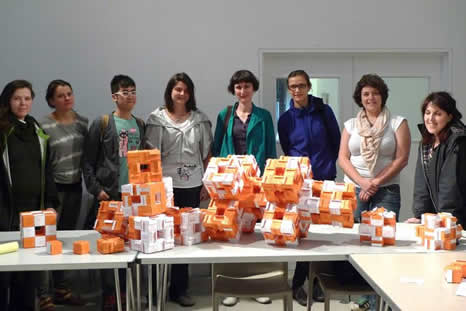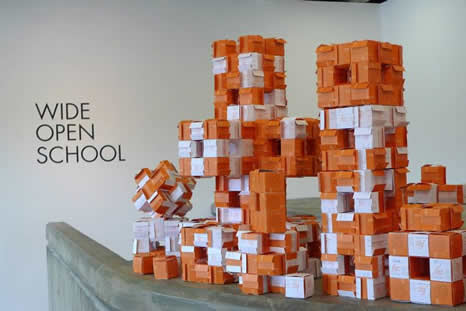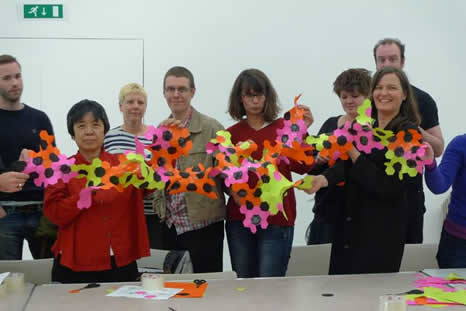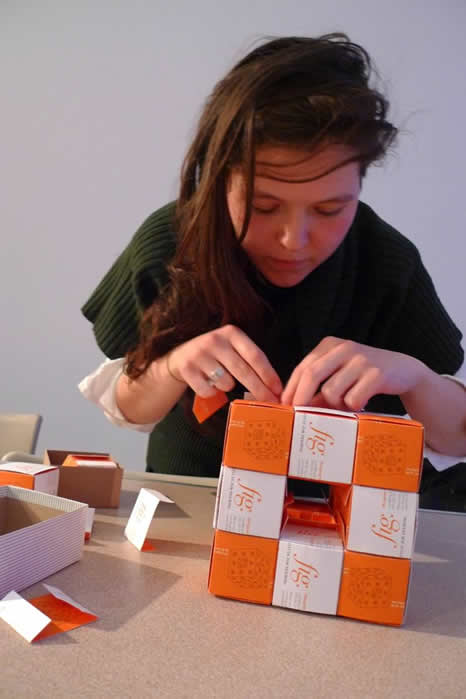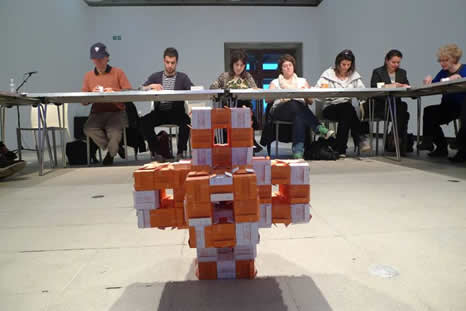 |
|
|||
Click here to view all Upcoming Events// IFF Directors Talks
IFF Directors Talks 2012 // Previous IFF Lectures THE MOSELY SNOWFLAKE SPONGE THE ART OF ITERATION MAKING SPACE IFF Director Margaret Wertheim speaks at Art Center College of Design Captain Charles Moore Talks About Plastic Trash IFF Director Margaret Wertheim Seeing Anew [IFF-L20] Structural Considerations of the Business Card
Sponge[IFF-L17] Where the Wild Things Are 2: Things That Think: Where the Wild Things Are: Crocheting the Hyperbolic Plane: Darwinism on a Desktop: The Logic Alphabet Why Things Don't Fall Down Kindergarten: Crocheting the Hyperbolic Plane [IFF-L5] The Mathematics of Paper Folding [IFF-L4] The Physics of Snowflakes [IFF-L3] Crocheting the Hyperbolic Plane [IFF-L2] The Figure That Stands Behind Figures: // Previous Events Crochet Hyperbolic Workshop |
MAKING SPACE WIDE OPEN SCHOOL PROJECT
Students constructing business card fractals at the Making Space class in the Hayward Gallery's Wide Open School. Photos © IFF Archive This summer the Hayward Gallery in London is turning itself into a school. During June and July, 100 artists from around the world, representing more than 40 countries, will give classes, talks and seminars about their artistic practice and the things that inspire them. During the first week of this unusual, international pedagogical experiment, IFF Director Margaret Wertheim will teach three days of intensive classes about concepts of space in physics and mathematics. Morning classes will focus on theory, with afternoons devoted to hands-on exercises using kindergarten-like techniques such as cutting and folding paper. Read about the classes on Margaret Wertheim's Guardian blog posting See Event Web Page at the Hayward Gallery
Business card fractal sculpture constructed by students in the IFF's Making Space classes. Class Schedule - Morning Theoretical Class [10am–12noon] June 12 - Day 1: Foundational Concepts in Geometry and Topology June 13 - Day 2: What is a Dimension? June 14 - Day 3: What is the spatial structure of our Universe.
Students construct a model of hyperbolic space in the "Making Space" class at the Hayward Gallery's Wide Open School. Original paper template from a design by Keith Henderson. Class Schedule - Afternoon Practical Class [2pm–5pm] June 12 - Day 1: Foundational Concepts in Geometry and Topology June 13 - Day 2: What is a Dimension? June 14 - Day 3: What is the spatial structure of our Universe.
Margaret explains the medieval concept of space that preceded the modern scientific understanding. Margaret Wertheim muses about the class and her lifelong interest in space: "When I was a child I was obsessed with the idea of space and time. Was time an illusion? Did it really exist, or was it just an artifact of our imaginations - or perhaps our language? What about space: What did it mean to say that we existed in space? How could we be in anything that wasn't made of the same stuff as us? Could a body logically be in an empty void? As I lay on the grass under the gum trees in Brisbane I had nowhere to turn for answers to these questions and they led me to dream that when I grew up I would study physics. I didn't really know what "physics" was, but I had read about the theory of relativity in a children's encyclopedia my mother had brought for myself and my siblings. Though I barely understood the words, I knew that Einstein had invented a theory about space and time and I wanted to know what it was. When I went to university I majored in physics but it wasn't until our final year that we learned about relativity. How on earth did human beings come to see the world this way, I wondered. This was the 1970's and the history and philosophy of science had yet to reach Queensland as an academic discipline. Eventually I decided that I needed to understand physics in a wider cultural context so I left academe and became a science writer. In my book The Pearly Gates of Cyberspace: A History of Space from Dante to the Internet, I set out to trace the historical evolution of Western scientific thinking about space. How did we go from the cosmos of Dante's Divine Comedy, with its endless layers of Heaven and Hell, to the infinite void of Newtonian physics, then the dynamic fabric of general relativity. What I came to realize in researching this book was that our conceptualizing of space is intricately bound up with our concept of ourselves. What we think it means to be human is literally tied to how we think about the space in which we live." Learn more about The Pearly Gates of Cyberspace.
PHOTO GALLERY
Making Space - Hayward Gallery Margaret with a hyperbolic model constructed by students in her "Making Space" class at the Hwyward Gallery's Wide Open Schol. Margaret explains the symmetries inherent a Level One Menger Sponge.
Student discovers symmetries in a Level One Menger Sponge.
A Level Two Viscek fractal constructed by students in the Making Space class at the Hayward Gallery's Wide Open School. |
|||
| © 2003–2018 The Institute For Figuring | ||||
